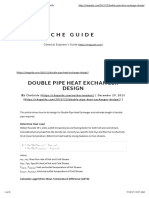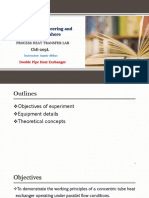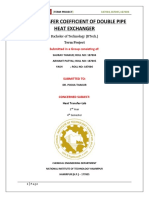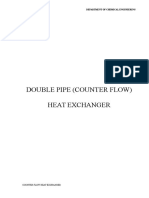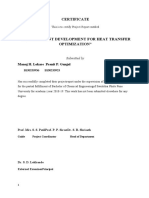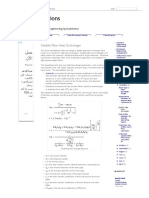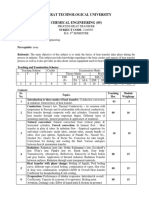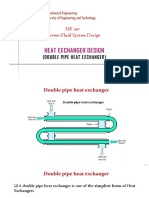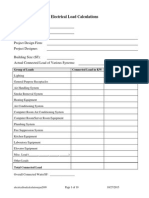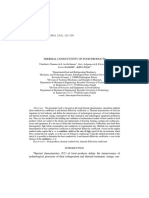Heat Exchanger CM3215 Lecture Morrison 11/5/2014
CM3215
Fundamentals of Chemical Engineering Laboratory
Overall Heat Transfer
Coefficient for Double-Pipe
Heat Exchanger
Professor Faith Morrison
Department of Chemical Engineering
Michigan Technological University
© Faith A. Morrison, Michigan Tech U.
CM3215 Fundamentals of Chemical Engineering Laboratory
hot side
Double-Pipe Heat Exchangers
cold
side
•Simplest type of
heat exchanger
•Total heat
T1 less hot
transferred
proportional to the
log-mean
temperature T1 T2
difference
cold less cold
•Counter-current
shown; co-current
also possible T2
hot
© Faith A. Morrison, Michigan Tech U.
1
�Heat Exchanger CM3215 Lecture Morrison 11/5/2014
CM3215 Fundamentals of Chemical Engineering Laboratory
Double-Pipe Heat Exchangers
T1 less hot
Steady state macroscopic T1 T2
energy balance on: cold less cold
•Inside
•Outside
T2
hot
•Overall
Covered in CM3110 Transport
Processes I
© Faith A. Morrison, Michigan Tech U.
CM3215 Fundamentals of Chemical Engineering Laboratory
Double-Pipe Heat Exchangers
T1 less hot
T1 T2
cold less cold
T2
hot
Δ Δ
• driving force for heat transfer
• Δ varies down the length of the heat exchanger (HE)
• Amount of heat transferred varies down the length of the HE
© Faith A. Morrison, Michigan Tech U.
2
�Heat Exchanger CM3215 Lecture Morrison 11/5/2014
CM3215 Fundamentals of Chemical Engineering Laboratory
Double-Pipe Heat Exchangers T1 less hot
T1 T2
• driving force for heat cold less cold
transfer T2
• Δ varies down the length of
hot
Δ Δ
the heat exchanger (HE)
• Amount of heat transferred
varies down the length of the
HE
The overall heat The correct average
transferred is driving force (as we
governed by the average show in CM3110) is the
driving force, Δ log mean
Comes from considering
the energy balances)
© Faith A. Morrison, Michigan Tech U.
CM3215 Fundamentals of Chemical Engineering Laboratory
Log Mean Driving Force The overall heat
transferred is governed
by the log mean driving
force
Driving Driving
temperature temperature
difference at the difference at the
left side of heat right side of heat
exchanger exchanger
Tlm
T1 T1 T2 T2
T T
Note: the log-mean
average temperature
ln 1 1
T2 T2 driving force will be a
number between these
two T’s
© Faith A. Morrison, Michigan Tech U.
3
�Heat Exchanger CM3215 Lecture Morrison 11/5/2014
CM3215 Fundamentals of Chemical Engineering Laboratory
T1
Double-Pipe Heat Exchangers
• Total Heat Transferred given by T1 T2
• The HE is characterized by its overall
heat transfer coefficient, T2
Δ
2 Δ
≡
Δ
© Faith A. Morrison, Michigan Tech U.
CM3215 Fundamentals of Chemical Engineering Laboratory
Where do we get ?
From the Equipment Schedule
(see website):
© Faith A. Morrison, Michigan Tech U.
4
�Heat Exchanger CM3215 Lecture Morrison 11/5/2014
CM3215 Fundamentals of Chemical Engineering Laboratory
We will record data (and first calculations) on the white
board in class – be prepared to do so
• Temperatures
• ΔT
• Heat flow (steam side)
• Heat flow (water side)
• , water side
• , steam side
Answer the SurveyMonkey (or Google forms) to submit your
data – be prompt!
© Faith A. Morrison, Michigan Tech U.
CM3215 Fundamentals of Chemical Engineering Laboratory
How do we measure ?
We will record data (and first calculations) on the white
board in class – be prepared to do so
• Temperatures Two ways:
• ΔT • Water side
• Heat flow (steam side)
• Steam side
• Heat flow (water side)
• Perform Macroscopic Energy
• Balances to obtain
, water side
• , steam side
Answer the SurveyMonkey (or Google forms) to submit your
data – be prompt!
© Faith A. Morrison, Michigan Tech U.
5
�Heat Exchanger CM3215 Lecture Morrison 11/5/2014
CM3215 Fundamentals of Chemical Engineering Laboratory
How do we measure ?
We will record data (and first calculations) on the white
board in class – be prepared to do so
• Temperatures Two ways:
• ΔT • Water side
• Heat flow (steam side)
• Steam side
• Heat flow (water side)
• Perform Macroscopic Energy
• Balances to obtain
, water side
• , steam side
Macro-E-Balance comes from CM2110 and CM2120;
see Answer the SurveyMonkey
our handout page for(or
Dr.Google forms) toE-
Morrison’s submit your
Balance
data – be prompt!
Notes: www.chem.mtu.edu/~fmorriso/cm310/Energy_Balance_Notes_2008.pdf
© Faith A. Morrison, Michigan Tech U.
CM3215 Fundamentals of Chemical Engineering Laboratory
Report 6: Overall Heat Transfer Coefficient for Double-Pipe Heat
Exchanger
•Pump water through inner pipe of double-pipe heat exchanger
•Flow steam through outer pipe of double-pipe heat exchanger
•Allow to come to steady state (monitor; prove steady state)
•Measure appropriate temperatures, flow rates and replicates
•Share raw data with classmates; use all data from your lab
station across 5 lab sections
•Calculate and report overall heat transfer coefficient; use two
different methods
•Report the process of achieving steady state
•Address all objectives in assignment memo
© Faith A. Morrison, Michigan Tech U.
6
�Heat Exchanger CM3215 Lecture Morrison 11/5/2014
Pneumatic Valve Position
© Faith A. Morrison, Michigan Tech U.
Note: The position of the valve stem is read from a set of
notches based on 1/8th distance per notch:
(compare to a x= fraction open
12 inch ruler)
8
8 7
CLOSED
6 8
8 (5.5)/8ths open
5
4 8
8 3
2 8
8
1
8
0
© Faith A. Morrison, Michigan Tech U.
7
�Heat Exchanger CM3215 Lecture Morrison 11/5/2014
CM3215 Fundamentals of Chemical Engineering Laboratory
Prelab Assignment:
• Review the following: concept of the double-pipe heat exchanger, the
overall heat transfer coefficient, logarithmic mean temperature
difference and purpose and operation of steam traps.
• Calculate the heat transfer area of the double pipe heat exchanger in
the lab. Base your calculation on the outside area of the inside pipe.
• Fit the latent heat of vaporization of steam over a reasonable
temperature range (near atmospheric pressure) to an empirical
function
• Be prepared to make some trial calculations
• Prepare a safety section
© Faith A. Morrison, Michigan Tech U.

